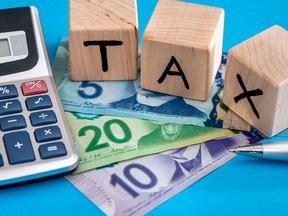Reviews and recommendations are unbiased and products are independently selected. Postmedia may earn an affiliate commission from purchases made through links on this page.
Marginal tax rate is important to know because it is the tax rate you can expect to save on your first dollar of deductions

Article content
By Julie Cazzin with Andrew Dobson
Q: How do you come up with your combined marginal tax rate? I live in Ontario and I look at charts showing the federal combined rate is 53.5 per cent. But when I look at Ontario’s rate alone and the federal rate alone, it comes out to less than this. I make $250,000 annually and am somewhat confused. Am I overlooking something? — Lorenzo
Advertisement 2
Story continues below
Article content
Article content
FP Answers: Your marginal tax rate is how much tax you pay on your next dollar of income. Your marginal tax rate may vary, though, since different rates apply on different sources of income. Marginal tax typically refers to the rate payable on ordinary income such as salary, registered retirement savings plan (RRSP) withdrawals or interest income. Other income sources like Canadian dividends and capital gains may be subject to a different tax rate at the same level of income.
Federal tax rates are consistent across Canada, so the tax brackets and percentages do not change based on where someone files. On the other hand, provincial tax rates and brackets vary from province to province.
For example, in Ontario, taxable income in the $53,360-to-$86,698 range has a marginal rate of 29.65 per cent whereas there are two different tax brackets in Nova Scotia for that same income range. There, income in the $53,360-to-$59,180 range has a marginal tax rate of 35.98 per cent, but it increases to 37.7 per cent from $59,181 to $74,999.
The top federal tax bracket is 33 per cent over $235,676 of taxable income in 2023 and for Ontario, it is 13.16 per cent for income topping $220,000. At first glance, Lorenzo, you would think Ontario’s top tax bracket was 46.16 per cent. However, the Ontario surtax causes a further adjustment to tax rates for a high-income taxpayer.
Article content
Advertisement 3
Story continues below
Article content
The formula is 20 per cent on Ontario tax payable of more than $5,315, plus 36 per cent on Ontario tax of more than $6,802 (effectively 56 per cent total on Ontario tax over $6,802). These thresholds start as low as $86,698 and $102,135 in taxable income, respectively.
Taking all this into consideration, a high-income earner in Ontario pays an incremental 7.73 per cent of provincial tax for a total provincial tax of 20.53 per cent due to this surtax. To walk through the math, add the 13.16 per cent rate to a 56 per cent increase and you get 20.53 per cent. If you take the federal rate of 33 per cent plus the combined Ontario total including surtax of 20.53 per cent, that gets you to 53.53 per cent.
Perhaps oddly, a senior living in Ontario may stand to pay up to 58.14 per cent in marginal tax at just $106,717 of income. This is higher than someone earning more than $1 million. The reason for this is they are facing a marginal tax rate of 43.41 per cent, and they would also have a 15 per cent Old Age Security recovery tax, which adds up to 58.14 per cent.
The examples above assume tax on fully taxable income sources such as salary or interest received. There are other rates of tax based on the type of income received. Other forms of taxable income include dividends and capital gains, both of which are taxed at lower rates than regular income.
Advertisement 4
Story continues below
Article content
Related Stories
Your marginal tax rate is important to know because it is the tax rate you can expect to save on your first dollar of deductions. It is also the tax rate you will pay on an extra dollar of income. Knowing your marginal tax rate can help you make decisions about the timing for deductions and income.
Your marginal tax rate should not be confused with your average tax rate, which is just your income tax divided by your income. It may be interesting to know your average rate, but it is not as important as the marginal tax rate that applies on your last dollar of income.
Andrew Dobson is a fee-only, advice-only certified financial planner (CFP) and chartered investment manager (CIM) at Objective Financial Partners Inc. in London, Ont. He does not sell any financial products whatsoever. He can be reached at adobson@objectivecfp.com.
Article content



Comments